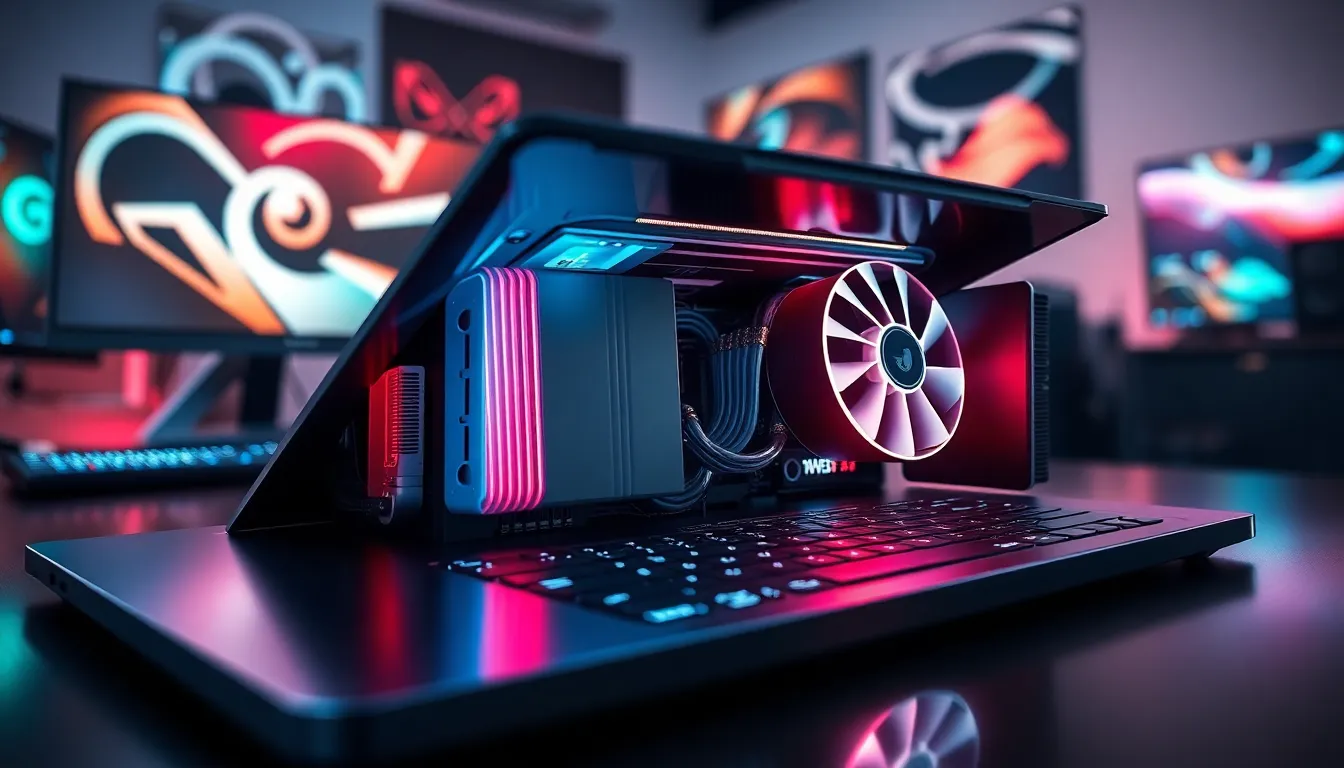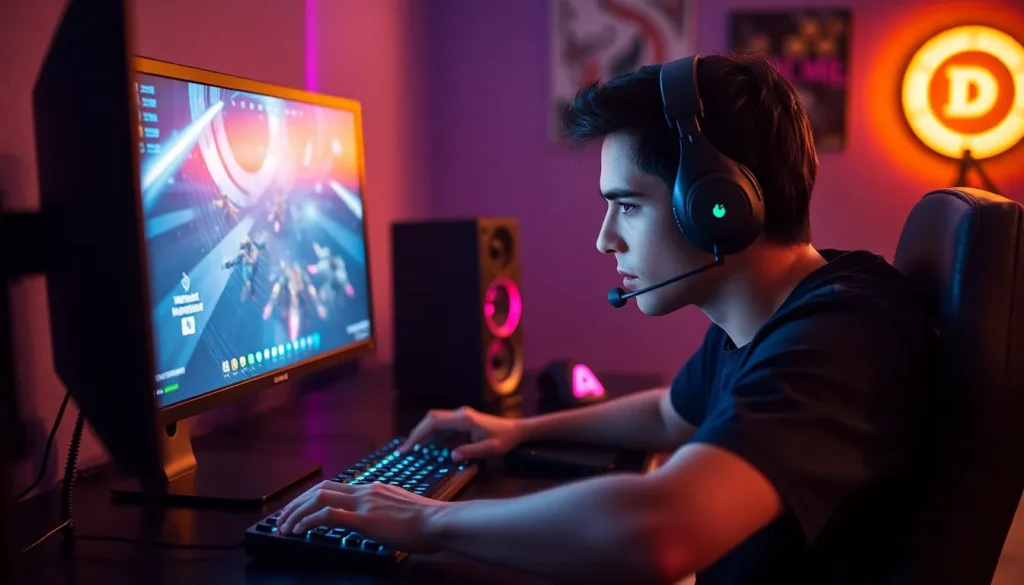Table of Contents
ToggleIn the world of laptops, the GPU is the unsung hero, tirelessly working behind the scenes to deliver stunning graphics and smooth gameplay. Choosing the right one can feel like picking a favorite child—impossible! With so many options out there, it’s easy to get lost in the specs and marketing jargon. Fear not, tech enthusiasts!
Overview of Laptop GPUs
Laptop GPUs play a critical role in determining a device’s performance, especially for graphics-intensive tasks like gaming, video editing, and 3D rendering. Various manufacturers produce GPUs, with NVIDIA and AMD dominating the market. Each brand offers a range of models suited for different needs and budgets.
NVIDIA’s GeForce series provides options from entry-level to high-end performance. The GTX and RTX lines cater to gamers, offering features like ray tracing and AI-enhanced graphics. Performance metrics, such as frames per second (FPS) in games, often reflect the capabilities of these GPUs.
AMD also offers competitive alternatives with its Radeon series. These GPUs often excel in multi-threaded applications thanks to their parallel processing capabilities. Many users appreciate the value AMD provides, typically offering strong performance at lower price points.
When considering a laptop GPU, it’s essential to evaluate specific requirements. Gamers may prioritize higher FPS and smooth gameplay. Designers often look for accurate color reproduction and rendering speed. Power consumption becomes crucial for those needing longer battery life, as more powerful GPUs often consume more energy.
Moreover, integrated GPUs provide a viable option for casual users. Devices equipped with integrated graphics can handle everyday tasks while maintaining energy efficiency. However, those seeking high-quality graphics will benefit from dedicated GPUs with their enhanced processing power.
Select a GPU based on individual needs and performance expectations. Keeping an eye on benchmarks and reviews can further aid in making an informed decision. With varying specifications and advancements, understanding the landscape of laptop GPUs remains paramount for users aiming for optimal performance.
Key Specifications to Consider

Selecting a laptop GPU involves understanding key specifications that influence overall performance. Three major factors stand out: performance metrics, power consumption, and thermal management.
Performance Metrics
Performance metrics like frames per second determine how smoothly games and applications run. Higher FPS measurements indicate better responsiveness during gaming sessions. Benchmarks provide insight into a GPU’s capabilities, allowing for informed comparisons between models. NVIDIA’s GeForce series and AMD’s Radeon series each deliver unique strengths; GeForce excels in ray tracing and AI enhancements while Radeon shines in multi-threaded tasks. Observing these metrics helps identify the GPU that aligns with specific gaming or professional needs.
Power Consumption
Power consumption plays a crucial role, especially for users prioritizing battery life. Lower power usage often leads to longer operational time between charges. GPUs like the NVIDIA GeForce MX series focus on efficiency while still delivering acceptable performance for everyday tasks. Likewise, AMD’s Radeon offerings balance consumption with sufficient output. Evaluating TDP (thermal design power) provides additional insight, guiding users in making choices that optimize energy efficiency while meeting performance standards.
Thermal Management
Thermal management impacts GPU performance and longevity. Effective cooling solutions prevent thermal throttling, which can hinder performance during intensive tasks. Laptops equipped with advanced cooling systems, such as vapor chambers or strategically placed vents, sustain optimal temperatures. Choosing a laptop with robust thermal management allows for extended sessions without performance dips. Brands emphasize varying designs, so reviewing specifications on cooling is essential for maintaining consistency during heavy usage.
Popular Laptop GPUs in 2023
In 2023, several laptop GPUs stand out for their performance and features. Tech enthusiasts should consider options from both NVIDIA and AMD when choosing the right graphics solution.
NVIDIA GeForce Series
NVIDIA’s GeForce series remains a leader in the market. It offers a wide range of GPUs catering to different performance needs. The GeForce RTX 3060, for instance, delivers excellent performance for mid-range gaming and creative tasks. Higher-end models, like the RTX 3080, excel in demanding gaming scenarios and support advanced technologies such as ray tracing and AI enhancements. Users seeking battery-efficient performance can also opt for the NVIDIA GeForce MX series, designed for casual gaming and everyday tasks without draining the battery. Overall, NVIDIA GPUs provide versatility and high performance for various users.
AMD Radeon Series
AMD’s Radeon series continues to compete effectively in the laptop GPU market. Strong performance characterizes models like the Radeon RX 6800M, which caters to gamers and content creators alike. This GPU delivers solid frame rates in demanding titles while maintaining competitive pricing. Additionally, the Radeon RX 6600M offers appealing performance for budget-conscious users. It provides reliable power for multi-threaded applications, making it an excellent choice for productivity-focused individuals. With advancements in architecture and features, AMD GPU options present compelling alternatives to NVIDIA counterparts.
Performance Comparison
Laptop GPU performance varies significantly based on the intended use. Understanding the distinctions helps users make informed choices.
Gaming Performance
Gaming performance evaluates how smoothly a laptop handles modern games. NVIDIA’s GeForce RTX 3080 excels in high settings, delivering over 60 FPS in AAA titles. AMD’s Radeon RX 6800M competes closely, offering impressive frame rates and visually stunning graphics. Users needing higher FPS often gravitate towards these GPUs for demanding gaming experiences. Each model features technologies, such as ray tracing, enhancing realism and immersion. The choice of GPU ultimately influences the overall gaming experience significantly.
Content Creation Performance
Content creation demands robust graphical capabilities for tasks like video editing and 3D rendering. NVIDIA’s GPUs lead with CUDA cores that accelerate rendering times, enabling faster project completion. AMD’s Radeon series caters to multi-threaded workflows, making it an excellent choice for simultaneous tasks. Both GPU brands support multiple high-resolution displays, crucial for designers and editors. Efficient GPUs reduce time spent on rendering and exporting projects. A strong GPU not only enhances productivity but also improves the quality of creative outputs greatly.
Benchmark Results
Benchmark results provide a quantifiable comparison of GPU performance. Various benchmarks, such as 3DMark and Unigine Heaven, assess graphical capabilities across models. For instance, the RTX 3060 commonly achieves high scores in gaming benchmarks, indicative of its reliability. The RX 6600M shows competitive scores, especially in multi-threaded performance scenarios. Users can refer to these benchmarks to make data-driven decisions. Ultimately, reviewing benchmark results enables users to align GPU capabilities with personal performance expectations effectively.
Price and Value Analysis
Price plays a significant role in GPU selection. Understanding price ranges helps users identify which GPUs provide features that fit their budgets.
Price Ranges
Prices for laptop GPUs vary widely, reflecting their features and performances. Entry-level GPUs like the NVIDIA GeForce MX series can cost around $600, making them accessible for casual users. Mid-range options like the GeForce RTX 3060 typically range from $1,000 to $1,500, targeting gamers seeking a balance of performance and affordability. Higher-end GPUs, such as the RTX 3080, often exceed $1,500, catering to enthusiasts who demand top-tier graphics. AMD’s Radeon RX series also presents competitive pricing, with models like the RX 6800M falling into similar price categories, ensuring users find options that suit various financial considerations.
Performance per Dollar
Evaluating performance per dollar enhances decision-making. Users typically find that mid-range GPUs offer the best value, delivering excellent performance for the investment. For instance, the GeForce RTX 3060 achieves around 60 FPS in modern games, making it a cost-effective choice for gamers. Higher-tier GPUs such as the RTX 3080 provide superior performance but at a steeper cost. AMD’s RX 6800M matches or exceeds performance similar to competing NVIDIA models, often at lower prices. Benchmark tests reveal the RX 6600M as another strong contender, offering great performance for users on tighter budgets. Prioritizing performance metrics against price allows informed selections that maximize users’ investment in laptop GPUs.
Choosing the right laptop GPU can significantly enhance a user’s experience whether for gaming or creative work. By understanding individual needs and evaluating key specifications, users can make informed decisions that align with their performance expectations. With strong contenders like NVIDIA and AMD offering a variety of options, there’s a GPU to suit every budget and requirement.
Prioritizing performance metrics such as frames per second and considering factors like power consumption will lead to a more satisfying experience. Ultimately, the right GPU choice not only boosts performance but also enriches the overall functionality of the laptop, making it an essential consideration for any tech enthusiast.







